Perhaps Walt Disney’s most personal feature film found itself performed on records during two different decades and labels—resulting in two very different productions.
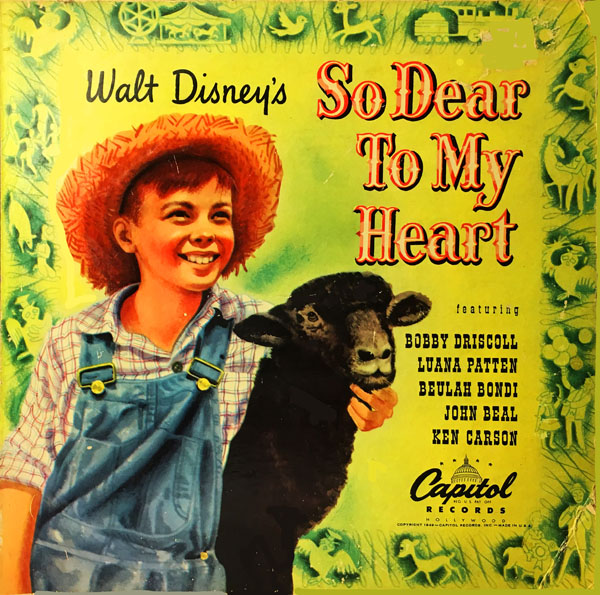
Walt Disney’s SO DEAR TO MY HEART
Capitol Records Children’s Series DD-109 (Four 10” 78-RPM Discs / Mono)
Released in 1949. Producer: Alan Livingston. Adaptation: Charles Palmer. Based on the Novel by Sterling North. Arranger/Conductor: Billy May. Running Time: 25 minutes.
Voices: Bobby Driscoll (Jerry Kincaid); Luana Patten (Tildy); Beulah Bondi (Granny Kincaid); John Beal (Narrator); Ken Carson (Uncle Hiram, Owl).
Songs: “So Dear to My Heart” by Ticker Freeman, Irving Taylor; “Old Dan Patch/Jerry’s Ram,” “Lavender Blue (Dilly, Dilly),” “Stick-to-it-ivity” by Eliot Daniel, Larry Morey; “County Fair,” by Mel Tormé, Robert Wells; “It’s What-cha Do With What-cha Got” by Don Raye, Gene DePaul.
 So Dear to My Heart is regarded as one of Walt Disney’s most personal films. One can only imagine how the Sterling North book delighted him, as it was such a romanticized portrait of farm life through the eyes of a young boy. It’s not so much a story as a sequence of events concerning Jerry’s attachment to a troublesome little lamb. No matter, the ethereal manner of the storytelling—both in the film and on this recording—is golden.
So Dear to My Heart is regarded as one of Walt Disney’s most personal films. One can only imagine how the Sterling North book delighted him, as it was such a romanticized portrait of farm life through the eyes of a young boy. It’s not so much a story as a sequence of events concerning Jerry’s attachment to a troublesome little lamb. No matter, the ethereal manner of the storytelling—both in the film and on this recording—is golden.
It’s one of Capitol’s finest adaptations, particularly because of the luxury of extra length. Covering eight 78-RPM disc sides, the production has a nice, even pace. That’s a somewhat rare quality among children’s records of this period, which had a brisk pace in order to get everything into 3 ½-minute segments.
Recreating their movie roles are Bobby Driscoll, Luana Patten and Beulah Bondi. Bondi’s character of Granny Kincaid, as well as her home, has become part of the continuing Disney legacy, as Walt himself created a miniature model of the farm house (with electricity) that was on display for many years at Disney’s Hollywood Studios.
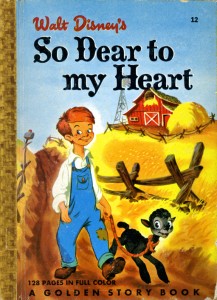 Walt also replicated the Kincaid barn for the Carolwood Pacific Railroad that he built in the backyard of his Holmby Hills home in California. Its current location is Griffith Park. Boasting a fine collection of Walt Disney memorabilia, the barn is the setting for regular events hosted by the Carolwood Society that take place every third Sunday.
Walt also replicated the Kincaid barn for the Carolwood Pacific Railroad that he built in the backyard of his Holmby Hills home in California. Its current location is Griffith Park. Boasting a fine collection of Walt Disney memorabilia, the barn is the setting for regular events hosted by the Carolwood Society that take place every third Sunday.
Also appearing on the Capitol album from the original cast is John Beal (1934’s The Little Minister, 1935’s Les Miserables, TV’s Dark Shadows) who narrates in the grownup role of Jerry, and Ken Carson (one of the original Sons of the Pioneers, who voices the Owl and sings “Lavender Blue” in place of Burl Ives, whose Decca contract kept him from recording for Capitol.
Billy May does his usual spectacular job with full orchestrations created just for the album. The songs are brief but not rushed. It’s too bad that this recording never showed up as a Capitol LP, but the fact that So Dear to My Heart wasn’t a mammoth box office hit could have been the reason. Just the same, the story received new life 15 years later on a totally different recording.
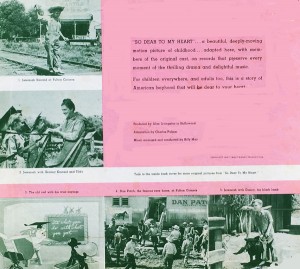


GIVE A LITTLE LISTEN
“So Dear to My Heart”
An excellent adaptation of the Disney charmer with full orchestrations and members of the original cast.
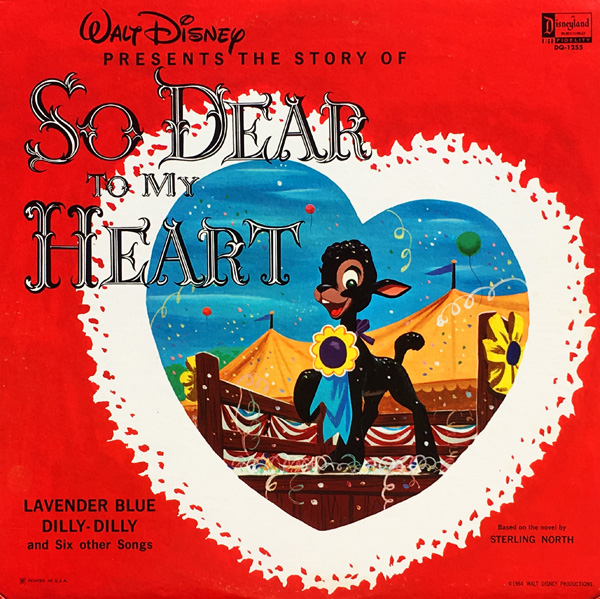
Walt Disney’s SO DEAR TO MY HEART
Disneyland Records DQ-1255 (12” 33 1/3 RPM / Mono)
Released in 1964. Based on the Novel by Sterling North. Executive Producer/Writer: Jimmy Johnson. Producer: Camarata. Running Time: 22 minutes.
Voices: Bryan Russell (Narrator), Carl Berg, Bill Kanady (Soloists); The Jack Halloran Singers.
Songs: “So Dear to My Heart” by Ticker Freeman, Irving Taylor; “Old Dan Patch/Jerry’s Ram,” “Lavender Blue (Dilly, Dilly),” “Stick-to-it-ivity” by Eliot Daniel, Larry Morey; “County Fair,” by Mel Tormé, Robert Wells; “It’s What-cha Do With What-cha Got” by Don Raye, Gene DePaul.
Perhaps in an effort to build up the Disneyland Records catalog, Jimmy Johnson and Tutti Camarata brought So Dear to My Heart back to records in 1964. “Lavender Blue” had not run out of steam as an Oscar-nominated standard, and a fresh approach was apparently in order for the groovy ’60s.
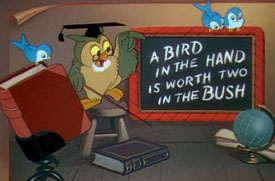 The result was a very unusual—borderline strange—approach for such an old-fashioned rural tale. “It’s What-cha You Do With What-cha Got” is given a twist beat and a choral arrangement reminiscent of commercial jingles of the era. The rendition of “Stick-to-it-ivity” would be right at home at one of Annette’s beach parties.
The result was a very unusual—borderline strange—approach for such an old-fashioned rural tale. “It’s What-cha You Do With What-cha Got” is given a twist beat and a choral arrangement reminiscent of commercial jingles of the era. The rendition of “Stick-to-it-ivity” would be right at home at one of Annette’s beach parties.
It’s a case of a Disneyland Records taking the popular music route that Hanna-Barbera Records started doing a year later. Only “Lavender Blue,” “Old Dan Patch,” and “Jerry’s Ram” are performed as simple folk tunes, with the title song done in an adult contemporary feel that unlike the movie version, but still faithful to the mood.
A fact worth noting regarding a song on both recordings: the song “County Fair” was written by singer Mel Tormé and his songwriting partner, Robert Wells—the duo responsible for all those musical chestnuts roasting upon open fires every holiday season.
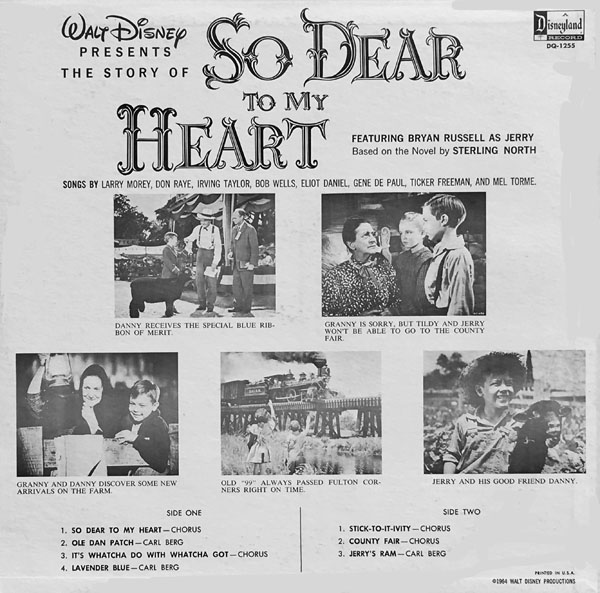
GIVE A LITTLE LISTEN
Ending Narration and “So Dear to My Heart”
As a tribute to Bryan Russell, who passed away last week, there’s a bit of his narration included here, followed by the title song. Russell was a busy child actor in the 1960’s, starring in Disney’s Emil and the Detectives, The Adventures of Bullwhip Griffin and Kilroy, as well as Bye Bye Birdie, The Wonderful World of the Brothers Grimm and many other films and TV shows.


 GREG EHRBAR is a freelance writer/producer for television, advertising, books, theme parks and stage. Greg has worked on content for such studios as Disney, Warner and Universal, with some of Hollywood’s biggest stars. His numerous books include Mouse Tracks: The Story of Walt Disney Records (with Tim Hollis). Visit
GREG EHRBAR is a freelance writer/producer for television, advertising, books, theme parks and stage. Greg has worked on content for such studios as Disney, Warner and Universal, with some of Hollywood’s biggest stars. His numerous books include Mouse Tracks: The Story of Walt Disney Records (with Tim Hollis). Visit 






















































So Dear To My Heart will always be dear to MY heart! The title tune is very touching and nostalgic, don’t care for the Camarata arrangement much. Beulah Bondi is the ideal grandmother, used so well in this production. I attended a revival show of the picture in the late 1960s at a nabe, and was saddened and rudely surprised by the audience reaction. They hooted at the picture and just made fun of it all the way through. At that point I really felt in the minority for loving this film as I do. But they’ve never dissuaded me, and I’ll love it all the rest of my life. Thanks, Greg, for featuring these recordings today.
Mark, you saw the revival at a..WHAT?
Steve: “nabe” is Variety-ese for “neighborhood theater.”
“Nabe” is jazzy film industry slang for a neighborhood theater, otherwise known as “neighborhood houses”. I think Variety coined the term.
This movie was apparently a marketing puzzle. There were posters that made it look like the story of a boy and a horse (built around one of the photos on the vertical poster shown); the album cover suggests an animated feature; and the Disney Movie Club DVD spotlights the girl — very much a secondary character — interacting with the animated characters. That DVD, by the way, includes a gallery of production / promotional art and Walt’s introduction for the television showing (guessing an uncompleted Vault Disney release). In the TV clip Walt sits behind a desk and zips through with no evident enthusiasm. Still disappointed at its original reception?
The idea of giving songs from “Se Dear To My Heart” a shot of modern sounds did not originate with Tutti Camarata.
In 1959, there was a vogue for taking old standards and semi-standards and dressing them up in modern style–sometimes with a little bit of “soul” thrown in.
Late that year, Bigtop Records relesed “Lavender Blue” by one Sammy Turner. It had a bit of “soul”, married to an uptown arrangement with strings and a chorus. Stan Appelbaum supplied the chart, and Phil Soector is said to be on guitar, although he is not out front if he is on the date at all. The record was produced by the successful pair of Jerry Lieber and Mike Stoller.
The record was a Top Ten hit,the only such success that Sammy Turner would ever have. An excellent transfer is on YT, done by “MusicProf78”.
And, James, let’s not forget in 1949 the several hit records of “Lavender Blue, Dilly Dilly”, today recommended for the purist or fan of the original: DInah Shore, Burl Ives himself, Sammy Kaye and his orchestra, and a guy named Jack Smith (not the 1920s “Whis[ering” one).
It was not intended to suggest that modernizing tunes originated with Camarata. “Blue Moon” is another example.
Billy May and His Orchestra, with vocals by Ken Carson, recorded the band tracks at Radio Recorders’ studios at 932 No4th Western Avenue in Hollywood, California for parts 1, 2, 3, and 4 on December 30, 1947, and for parts 5, 6, 7, and 8 on December 31, 1947 (the last day before the second AFM recording ban began.
John Beal, Bobbie Driscoll, Luanna Patten, and Beulah Bondi (as Granny Kincaid) recorded vocal overdubs at the Walt Disney Studios in Burbank, California for parts 1, 2, 3, and 4 on June 10, 1948, and for parts 5, 6, 7, and 8 on June 17, 1948.
After additional vocals are overdubbed by The Starlighters (vocalists Vince Degen, Tony Paris, Pauline Byrns, Jerry Duane, and Howard Hudson) and wild tracks of sound effects are recorded in Los Angeles, California, both on July 29, 1948, Capitol Records issued the final mixes of all the parts on the children’s album “Walt Disney’s So Dear To My Heart” (DD-109 on four 10″ shellac discs and CDF-3000 on four 7″ vinyl discs) and on the compliation album “Rusty In Orchestraville/So Dear To My Heart” (P-3068 on 12″ vinyl).
I have the 1948 records album “so dear to my heart” as well as “Looney Tunes”. My dad bought them for me for Christmas and I’m wondering in 2018 what are they worth 70 yrs later?
I’m looking for one missing record in my album.